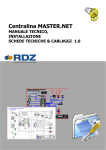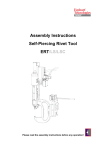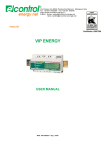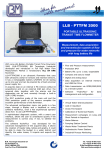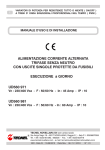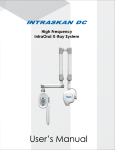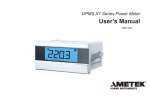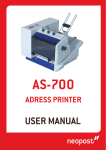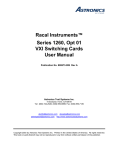Download ELECTROMAGNETIC FLOW METER
Transcript
ELECTROMAGNETIC FLOW METER
0000137643
Rev. 1.0
INSTALLATION MANUAL
EN
MANUALE D’ INSTALLAZIONE
IT
0000137643
Rev. 1.0
DI.MPO 02
ELECTROMAGNETIC FLOW METER
0000137643
Rev. 1.0
1
INDEX
1. MAIN FEATURES............................................................................................................................. 3
ADJUSTABLE BETWEEN 0.1 AND 99 SECONDS .......................................................................... 3
2. TECHNICAL DATA.......................................................................................................................... 3
3. FLOW TABLES FOR OPTIMAL DIAMETER SELECTION .................................................... 4
4. OPERATION...................................................................................................................................... 5
4.1 MEASURING CRITERION .........................................................................................................................5
5. DIMENSIONS .................................................................................................................................... 6
5.1 DIMENSIONS OF COMPACT VERSION (FIG.2 -TAB.1)............................................................................6
5.2 DIMENSIONS OF THE REMOTE VERSION (FIG.3 - TAB 2)......................................................................7
6. INSTALLATION................................................................................................................................ 8
6.1 SAFETY MEASURE ...................................................................................................................................8
6.2 WARNINGS ...........................................................................................................................................8
6.3 PRE-INSTALLATION .........................................................................................................................8
6.4 REQUIREMENT FOR ELECTRIC CONNECTION .......................................................................................9
6.5 ENVIRONMENTAL CONSIDERATIONS........................................................................................9
6.6 MOUNTING ..............................................................................................................................................9
6.7 CONDITIONS FOR INSTALLATION ..........................................................................................................9
6.8 SELECTING THE PLACE FOR INSTALLATION .........................................................................................9
6.9 GROUNDING ..........................................................................................................................................10
6.10 PREPARATION FOR OPERATION .........................................................................................................11
7. ELECTRIC CONNECTION........................................................................................................... 12
7.1 INSTALL CONDUIT ................................................................................................................................12
7.2 POWER CONNECTIONS .........................................................................................................................12
7.3 USCITE...................................................................................................................................................12
7.4 REMOTE VERSION.................................................................................................................................13
8. QUICK START UP .......................................................................................................................... 13
8.1 TRANSMITTER ......................................................................................................................................13
8.2 FLOWTUBE ............................................................................................................................................13
8.3 PROCESS FLUID .....................................................................................................................................13
9. LOCAL OPERATOR INTERFACE (LOI)................................................................................... 14
9.1 SAFETY MESSAGES .........................................................................................................................14
9.2 WARNINGS .........................................................................................................................................14
9.3 LOI FEATURES..................................................................................................................................14
9.4 LOI ROTATION .................................................................................................................................15
9.5 DATA ENTRY .....................................................................................................................................15
9.6 DISPLAY PAGES................................................................................................................................16
9.7 LOI MENU...........................................................................................................................................16
9.7 KEYBOARD LOCK............................................................................................................................26
10. TROUBLESHOOTING................................................................................................................. 27
11. CONTENTS OF DELIVERY........................................................................................................ 27
12. PRECAUTIONS FOR TRANSPORT AND STORAGE............................................................ 27
0000137643
Rev. 1.0
2
1. MAIN FEATURES
1.1 Flow Range
The DI.MPO 02 is able to elaborate signals from fluids with a 10m/s flow speed in both ways (bidirectional
transmitter).
1.2 Conductivity of the fluid
The fluid must have more thaan a 5 microsiemens/cm conductivity.
1.3 Power supply
85÷265Vac, 24Vac oraw 24Vdc depending by the model.
1.4 Consumption
Typical 6W, max. 8W.
1.5 Temperature Range
Processo: -20÷75°C (-4÷167°F).
Stoccaggio: -40÷85°C (-40÷185°F).
1.6 Output signals
4÷20mA: 0÷750 ohm load.
Frequency: 0÷5000 Hz
Pulse: possibility to set the pulse width, the status of the H or L output and to connect the internal pullup resistor trough JP1
1.7 Reverse flow
Instant and totalized reverse flow measure.
1.8 Output signals test
Analogue output: the transmitter can generate a 4-20mA output signal.
Frequency output: il trasmettitore può generare il segnale in uscita da 0.1 a 5000 Hz
1.9 Start-up time
0.5s from a zero flow.
1.10 Flow Cut-off
Adjustable between 0,0 e 9,9% of the Qmax. Below the set value, visualization of instantant flow and
outputs are forced to zero.
1.11 Relative humidity
0÷100% RH a 65 °C (150 °F), noncondensing.
1.12 Damping
Adjustable between 0.1 and 99 seconds
2. TECHNICAL DATA
2.1 Accuracy
±0,5%of the measured value in a 0,2÷10m/s range.
2.2 Ripeatability of the measure
± 0,1% of the measured value.
2.3 Time of response
Max. 0,2 seconds.
2.4 Stability
± 0.1% of the flow speed for more than a 6 months period.
0000137643
Rev. 1.0
3
3. FLOW TABLES FOR OPTIMAL DIAMETER SELECTION
Flows from DN3 to DN500
(Min. Standard DN15)
Flows from DN600 to DN2000
(Max. Standard DN1600)
0000137643
Rev. 1.0
4
4. OPERATION
4.1 Measuring criterion
Every electromagnetic flow meter works according to the Faraday law (fig.1):
Fig.1
Um = K x B x V x D
Um – Induced voltage measured between the two electrodes.
K – Adjustment factor of the sensor.
B – Magnetic induction.
V – Speed of the fluid.
D –Internal diameter of the measuring pipe.
The passage of conductive liquid through the induced magnetic field generates an induced voltage that is
used to measure the flow. The magnetic field produced by coils driven by current flows through the
measuring tube and the fluid that has passed through. It thus generates a voltage in the fluid that is
proportional to the speed of the fluid. The voltage is measured through two electrodes.
0000137643
Rev. 1.0
5
5. DIMENSIONS
5.1 Dimensions of compact version (Fig.2 -Tab.1)
Fig.2
Tab.1
ATTENTION: The flanges are connected to the sensor produced according to the metric system. When
choose the flanges, the pressure of operation of the tube must be specified in the order.
DN
(mm)
10
15
20
25
32
40
50
65
80
100
125
150
200
250
300
350
400
450
500
600
700
800
900
1000
P
(Mpa)
4.0
4.0
4.0
4.0
4.0
4.0
4.0
1.3
1.6
1.6
1.6
1.6
1.0
1.0
1.0
1.0
1.0
1.0
1.0
1.0
1.0
1.0
1.0
1.0
Sensor Dimensions (mm)
a
b
c
e
200
342
90
200
342
95
200
342
105
205
320
115
205
340
140
205
347
150
205
360
165
205
395
185
205
395
200
255
405
220
255
415
250
306
475
285
357
533
340
450
587
395
310
500
657
445
310
500
747
505
450
600
791
565
450
600
817
615
450
600
897
670
450
600
968
780
610
700
1070
895
610
800
1167
1015
610
900
1267
1115
700
1000 1377
1230
700
D
95
115
140
150
165
185
200
235
220
270
250
300
285
340
340
395
405
445
460
505
520
565
580
Flanges (mm)
Do
n
60
4
65
4
75
4
85
4
100
4
4
110
125
4
145
4
160
8
180
8
210
8
240
8
295
8
350
12
400
12
460
16
515
16
565
20
620
20
725
20
840
24
950
24
1050 28
1160 28
A
14
14
14
14
18
20
24
26
26
22
28
24
30
24
26
26
28
32
28
32
30
36
32
38
Weight
(Kg)
6
6
6
7
9
10
12
17
17
22
24
35
45
84
102
123
147
212
209
252
352
462
550
680
Dimensions of the flanges are usually provided according to the UNI2223 standard
0000137643
Rev. 1.0
6
5.2 Dimensions of the remote version (Fig.3 - Tab 2)
Fig.3
Tab.2
ATTENTION: The flanges are connected to the sensor produced according to the metric system. When
choose the flanges, the pressure of operation of the tube must be specified in the order.
DN
(mm)
10
15
20
25
32
40
50
65
80
100
125
150
200
250
300
350
400
450
500
600
700
800
900
1000
P
(Mpa)
4.0
4.0
4.0
4.0
4.0
4.0
4.0
1.3
1.6
1.6
1.6
1.6
1.0
1.0
1.0
1.0
1.0
1.0
1.0
1.0
1.0
1.0
1.0
1.0
Sensor Dimensions (mm)
a
b
c
e
200
245
90
200
245
95
200
245
105
205
223
115
205
243
140
205
250
150
205
263
165
205
298
185
205
298
200
255
308
220
255
318
250
306
377
285
357
435
340
450
490
395
310
500
560
445
310
500
649
505
450
600
693
565
450
600
720
615
450
600
800
670
450
600
870
780
610
700
972
895
610
800
1070
1015
610
900
1170
1115
700
1000 1280
1230
700
D
10
15
20
25
32
40
50
65
80
100
125
150
200
250
300
350
400
450
500
600
700
800
900
1000
Flange (mm)
Do
n
60
4
65
4
75
4
85
4
100
4
4
110
125
4
145
4
160
8
180
8
210
8
240
8
295
8
350
12
400
12
460
16
515
16
565
20
620
20
725
20
840
24
950
24
1050 28
1160 28
A
14
14
14
14
18
20
24
26
26
22
28
24
30
24
26
26
28
32
28
32
30
36
32
38
Peso
(Kg)
4
4
4
5
7
8
10
15
15
20
22
33
43
82
100
121
145
210
207
250
350
460
550
680
Dimensions of the flanges are usually provided according to the UNI2223 standard
0000137643
Rev. 1.0
7
6. INSTALLATION
6.1 Safety measure
Instructions and procedures in this section may require special precautions to ensure the safety of the personnel
performing the operations. Information that raises potential safety issues is indicated by a warning symbol .
Please refer to the following safety messages before performing an operation preceded by this symbol.
6.2 WARNINGS
6.2.1 Explosions could result in death or serious injuryies
- Verify that the operating atmosphere of the flowtube and transmitter is consisten with the appropriate
hazardous locations certifications.
- Do not remove the transmitter cover in explosive atmospheres when the circuit is alive.
- Before connecting a HART-based communicator in an explosive atmosphere, make sure the instruments
in the loop are installed in accordance with intrinsically safe or non-incendive field wiring practices.
- Both transmitter covers must be fully engaged to meet explosion-proof requirements.
6.2.2 Failure to follow safe installation and servicing guidelines could result in death or serious injury
- Make sure only qualified personnel perform the installation.
- Do not perform any service other than those contained in this manual unless qualified
6.2.3 High voltage that may be present on leads could cause electrical shock
- Avoid contact with leads and terminals.
6.3 PRE-INSTALLATION
There are several pre-installation steps that make the installation process easier. They include identifying the
options and configurations that apply to your application, setting the hardware switches if necessary, and
consideration of mechanical, electrical, and environmental requirements. Please remember that the flowtube
liner is vulnerable to handling damage. Never place anything through the flowtube for the purpose of lifting or
gaining leverage.Liner damage can render the flowtube useless.
6.3.1 Identify Options and Configurations
Standard application of the DI.MPO 02 includes control of the flowtube coils and one or more
following configurations or options:
- 4÷20 mA Output
- Pulse Output
Be sure to identify the options and configurations that apply to your situation, and keep a list of them
nearby during the installation and configuration procedures.
6.3.2 Mechanical Considerations
The mounting site for the DI.MPO 02 Integral Mount Transmitter should provide enough room for
secure mounting, easy access to the conduit ports, full opening of the transmitter covers, and easy
readability of the local operator interface (LOI) screen (see Figure 2-1).The LOI can be rotated in 90°
increments. This should be performed prior to installing the magnetic flowmeter system.
.
Figura 2-1 dimensions of the DI.MPO 02 Transmitter
0000137643
Rev. 1.0
8
6.4 Requirement for electric connection
Before making any electrical connections to the DI.MPO 02 consider the following standards and be sure to
have proper power supply, conduit, and other accessories.
6.4.1 Conduit Connections
The DI.MPO 02 Transmitter has 4 M16*1.5 conduit
connections. 6.4.2 Transmitter Input Power
The DI.MPO 02 Transmitter is designed to be powered by voltages ranging 85÷265Vac (50 a 60 Hz), 24Vac
or 24Vdc.
6.4.3 DC Power Requirements
Units powered with 24Vdc may draw up to 2 amps of current. As a result, the input power wire must
meet certain gauge requirements.
6.4.4 Disconnects
The supply wires should be connected to the device through an external disconnect or circuit breaker.
The disconnect or circuit breaker should be clearly labeled and located near the transmitter.
6.4.5 Overcurrent Protection
The DI.MPO 02 requires overcurrent protection of the supply lines. Maximum rating of overcurrent
devices are as follows:
6.5 ENVIRONMENTAL CONSIDERATIONS
To ensure maximum transmitter life, avoid excessive heat and vibration.Typical problem areas include highvibration lines with integrally Mounted transmitters, warm-climate installations in direct sunlight, and outdoor
installations in cold climates. Because the DI.MPO 02 System requires external power, access to a suitable
power source must be ensured.
Overheating will damage the flowtube. Do not encapsulate the flowtube with heating elements.
6.6 Mounting
Electric magnetic flow meter has a flanged connector, and meets standard UNI EN 1092-1 ( Ex UNI 2223).
6.7 Conditions for installation
1) The DI.MPO 02 must by mounted in dry and well ventilated site. Not install the instrument in the place where the
water is easily accumulated.
2) The instrument should not be exposed. Shelter is needed where the instrument is installed outside.
3) Vibration should be avoided in the place where the instrument is to be installed.
4) Keep the instrument away from strong magnetic field where big electric motor or transformer are installed.
5) The place where the instrument is installed shall be accessible for maintenance.
6.8 Selecting the place for installation
1) The arrow mark on the sensor must be in accordance with the medium flow direction in the pipeline.
2) The sensor must be full with the medium all the time.
3) The straight length of the upstream pipeline must not be less than 5xD, and the downstream 3x3D, where D
is the inner diameter of the pipe, and the middle of the sensor can be a point of the lengths.
0000137643
Rev. 1.0
9
6.9 Grounding
The grounding of the instrument must be satisfied because the signal the instrument
measured is very weak, only a few milli-voltages, even at its full range. See figure 9
for the grounding position. There are two requirements for grounding:
1) The sensor and the fluid must be equipotential.
2) Special grounding fitting must be assembled when electromagnetic disturbance
is greater. Total section area of the wires for grounding shall be greater than 4mm2
with multicore threads of copper. Grounding wire cannot be connected on electric
motor or common grounding's for all other equipment in case of the influence
occurred from any electric current leakage.
The resistance of grounding shall be less than 10 ohm. See figure 10.
The sensor must be assembled with grounding rings or flanges on its both sides, or a short pipe on which there
is an electrode for grounding when the sensor shall be installed on plastic pipeline or the pipeline has insulated
liner.
0000137643
Rev. 1.0
10
6.10 Preparation for operation
Strictly check the installment and wirings before it gets into operation!
It shall be pointed out that the instrument, including the sensor and converter has been fully adjusted,
calibrated with actual flow, and inspected under strict measures. All shipped units are certified. No
further adjustments are required when put it into operation. Observing the contents in this manual, to
check and analyze any malfunction.
The following steps are to be followed to get the instrument into operation.
1) Make sure that the sensor is completely filled with fluid.
2) Turn on the power supply. One minute late, the value displayed in the indicator will reach some amount,
which means the connections of wires are correct. If the flow direction is wrong, then change the flow
direction on the converter..
3) Zero verification. Shut off the valve tight in downstream first and then the valve in upstream, to let the
medium in the pipeline stops. The displayed value should be 0. The value displayed can be corrected at the
converter if the value is different than 0: ensure that no leaks.
0000137643
Rev. 1.0
11
7. ELECTRIC CONNECTION
You should use the cable with circular section when electric connection because of the seal of the cable glands.
7.1 Install conduit
Transmitter junction boxes have n.4 M16*1.5 conduit connections.
Seal unused ports to prevent moisture or other contamination from entering the junction box.
Do not overtighten metal plugs used to seal wiring compartment ports,overtightening can damage the housing.
7.2 Power connections
To connect power to the transmitter, complete the following steps:
1) Open the power terminal cover.
2) Run the power cable through the conduit to the transmitter.
3) Loosen the terminal cable guard for the input power terminals L and N or + and -.
4) Connect the power cable leads as follows:
For an AC-powered transmitter (fig.2-13):
- Connect AC Ground to a grounding lug.
- Connect AC Neutral to terminal N.
- Connect AC Line to terminal L.
For a DC-powered transmitter (fig.2-13):
- Connect DC Ground to a grounding lug.
- Connect + DC.
- Connect - DC.
7.3 Uscite
Satisfy these requirements before attempting to install and operate the
DI.MPO
02
6.3.1 Analog
output
The loop may be powered from the transmitter itself. Resistance in the loop must be 750ohms or less.
6.3.2 Digital output
The digital output, if set frequency mode generates an output signal from 0 to 5000Hz Max. proportional to
flow rate, if set in pulse mode generates an output signal in relation to totaled volume increasing. The signal
is normally used in conjunction with an external totalizer or control system. complete the following steps to
connect the signal cable to the transmitter:
1) Run the signal cable into the transmitter.
2) Connect the two wires that convey switch closure information to the F+ and F- terminals
6.3.3 RS485 serial output
In models with RS485 option can communicate via Modbus . Connect the serial cable to terminals A + and
B-
0000137643
Rev. 1.0
12
7.4 Remote version
To connect the sensor to the transmitter respect the matching cables:
8. QUICK START UP
8.1 Transmitter
Check that the analog range of the transmitter matches the analog range in the control system.
8.2 Flowtube
1. For horizontal flow installations, ensure that the electrodes are in a plane such that they remain covered
by process fluid.
2. For vertical or inclined installations, ensure that process fluid is flowing up into the flowtube to keep the
electrodes covered by process fluid.
3. Ensure that the grounding straps on the flowtube are connected to grounding rings, lining protectors, or
the adjacent pipe flanges. Improper grounding will cause erratic operation of the system.
8.3 Process fluid
1. The process fluid conductivity must be greater than 5 microS.
2. Process fluid must be free of air and gasses.
Completed the mechanical installation and electrical connections, the DI.MPO 02 is ready to start. May
still be necessary to verify the units ("Units PV" / "Total Units") and the 100% flow value (Qmax (m3 /
h) ") in accordance with plant requirements.
0000137643
Rev. 1.0
13
9. LOCAL OPERATOR INTERFACE (LOI)
The LOI option is an operator communications center for the DI.MPO 02 Through the LOI, the operator can
access any transmitter function for changing configuration parameter settings, checking totalized values, or
other functions.
9.1 SAFETY MESSAGES
Instructions and procedures in this section may require special precautions to ensure the safety of the personnel
performing the operations. Information that raises potential safety issues is indicated by a warning symbol:
Please refer to the following safety messages before performing an operation preceded by this symbol.
.
9.2 WARNINGS
Explosions could result in death or serious injury
- Verify that the operating atmosphere of the flowtube and transmitter is consistent with the appropriate
hazardous locations certifications.
- Do not remove the transmitter cover in explosive atmospheres when the circuit is alive.
- Before connecting a HART-based communicator in an explosive atmosphere, make sure the instruments in
the loop are installed in accordance with intrinsically safe or non-incendive field wiring practices.
- Both transmitter covers must be fully engaged to meet explosion-proof requirements.
Failure to follow safe installation and servicing guidelines could result in death or serious injury
- Make sure only qualified personnel perform the installation.
- Do not perform any service other than those contained in this manual unless qualified
High voltage that may be present on leads could cause electrical shock
- Avoid contact with leads and terminals
9.3 LOI FEATURES
The LOI option contains a four-line, 16-character liquid crystal display (LCD) that is back-lit and visible from
any angle. There are four touch keys on the pad, and a infrared decoder to receive keys that on the
remote encoder. Table 3-1 lists and details the functions of the LOI keys.
0000137643
Rev. 1.0
14
9.4 LOI ROTATION
Each magnetic flowmeter installation is different from application to application; therefore, the LOI display can
be rotated to accommodate various setups using the following procedure:
1. Remove power from the transmitter
2.
Unscrew and remove the LOI cover. Do not remove the cover in explosive atmospheres when the
circuit is alive.
3. Unfasten the 4 screws that attach the LOI assembly to the main circuit assembly.
4. Carefully remove the LOI assembly by pulling it away from the transmitter.
5. Position the LOI in a preferred 90° rotation.
6. Fasten the 4 screws that attach the LOI to the main circuit assembly.
7. Replace the LOI cover
9.5 DATA ENTRY
The LOI keypad has no numerical keys. Enter numerical data using the following procedure:
1. Access the appropriate function.
2. Use
to highlight the digit you want to enter or change.
3. Use or to change the highlighted value.
For numerical data, or toggles through the digits 0÷9,decimal point; For alphabetical data, they toggle
through the letters of the alphabet A-Z, digits 0÷9, and the symbols &, +, -, *, /, $, @, %, and the blank
space ( or is also used to toggle through pre-determined choices that do not require data entry).
4. Use
to highlight and change other digits you want to change.
5. Press
sertion of data.
0000137643
Rev. 1.0
15
9.6 DISPLAY PAGES
The DI.MPO 02 has three pages to display data and status, press
page
or
to change
9.7 LOI MENU
Press the
key from run mode: the display will show the list of configuration menu as
shown here next.
Press the or keys to select the desired menu, then press the
key to access.
0000137643
Rev. 1.0
16
9.7.1 Basic configuration
Press the
key from run mode: the display will be as shown here next, then
press
to enter the "Basic" menu
Press the or keys to select the desired function and press the key to access
9.7.1.1 - PV Units
PV Units variable specifies the format in which the flow rate will be
displayed.
Default: m3/h. Range: L/s; m3/s; G/s; L/m; m3/m; G/m; L/h; m3/h; G/h.
Press
key from run mode: the display will be as shown here next.
Press or to select the measure unit.
Press
to confirm, the display will be as shown here next.
Press the
key to exit and confirm the selection; press the
key to exit and
delete the selection.
9.7.1.2 - PV Decimal
PV Decimal specifies how many decimals are displayed after the decimal
point.
Default: 3
Range: 1÷3
Press
key from run mode: the display will be as shown here next.
Press or to select the decimal number places to display.
Press
to confirm, the display will be as shown here next.
Press the
key to exit and confirm the selection; press the
delete the selection.
key to exit and
9.7.1.3 - Total Units
Total Units specifies the counter display unit.
Default: m3
Range: L, Litri; m3, Metri cubi; G, galloni
Press
key from run mode: the display will be as shown here next.
Press or to select the counter display unit.
Press
to confirm, the display will be as shown here next.
Press the
key to exit and confirm the selection; press the
key to exit and
delete the selection.
9.7.1.4 - Total Decimal
Total Decimal specifies how many decimals are displayed after the decimal
point.
Default: 3 Range: 1÷3
Press
key from run mode: the display will be as shown here next.
Press or to select the decimal number places to display.
Press
to confirm, the display will be as shown here next.
Press the
key to exit and confirm the selection; press the
key to exit and
delete the selection.
0000137643
Rev. 1.0
17
9.7.1.5 - Damping (s)
Damping(S) sets the delay time in seconds for changes in reading. It 'used to
mitigate the fluctuations in flow measurement.
Default: 1; Range: 0.1÷99.9
Press
key from run mode: the display will be as shown here next.
Keys or change the digit,
moves the cursor.
Press
to confirm, the display will be as shown here next.
Press the
key to exit and confirm the selection; press the
key to exit and
delete the selection.
9.7.2 System Configuration (System)
Press the
key from run mode, then press to select “System”, then press
to enter the menu.
To access the menu "System" may need to enter the correct password. Default
password is: 0100
After entering, it is possibile to change the password.
Note: In case of lost password, it won’t be possible to access the menu.
9.7.2.1 - Language
Allows menu language selection
Deafult: English
Press
key from run mode: the display will be as shown here next.
Press or to select the language.
Press
to confirm, the display will be as shown here next.
Press the key to exit and confirm the selection; press the key to exit and
delete the selection.
9.7.2.2 - Signal
Press
key to axcess the submenu “Signal”.
9.7.2.2.1 - Qmax (m3/h)
Set the flow measurement 100%. This value adjusts the analog output end
scale (20mA) and the frequency output end scale.
The range is related to the sensor DN.
0000137643
Rev. 1.0
18
Press
key from run mode: the display will be as shown here next.
Keys or change the digit,
moves the cursor.
Press
to confirm, the display will be as shown here next.
Press the key to exit and confirm the selection; press the key to exit and
delete the selection.
9.7.2.2.2 - LowCutoff %
Low Cutoff specifies the Qmax% value below which the instantaneous flow
measurement reading (direct or reverse) and the outputs are forced to zero.
Default: 0.0 Range: 0.0÷9.9
Press
key from run mode: the display will be as shown here next.
Keys or change the digit,
moves the cursor.
Press
to confirm, the display will be as shown here next.
Press the key to exit and confirm the selection; press the key to exit and
delete the selection.
9.7.2.2.3 - Max Limit %
When the measure variation is lower than Max Limit%, or higher but with a
lower time period than that set in Limit Time (s), the measure is not detected.
When the measure variation is higher than Max Limit% and with a higher time
period than that set in Limit Time (s), the measure is detected.
Default: 0.0 Range: 0.0÷9.9
Press
key from run mode: the display will be as shown here next.
Keys or change the digit,
moves the cursor.
Press
to confirm, the display will be as shown here next.
Press the key to exit and confirm the selection; press the key to exit and
delete the selection.
9.7.2.2.4 - Limit Time (s)
Sets the time limit used by the function Max Limit%.
Default: 00.0
Range: 00.0÷99.9
Press
key from run mode: the display will be as shown here next.
Keys or change the digit,
moves the cursor.
Press
to confirm, the display will be as shown here next.
Press the key to exit and confirm the selection; press the key to exit and
delete the selection.
9.7.2.2.5 - Direction
This parameter enables the flow direction measurement
Default: Fwd (positive flow)
Range: Fwd (positive flow); Rev (Negative flow); Bid. (bidirectional flow)
Press
key from run mode: the display will be as shown here next.
Press or to select the parameter setting.
0000137643
Rev. 1.0
19
Press
to confirm, the display will be as shown here next.
Press the key to exit and confirm the selection; press the
delete the selection.
key to exit and
9.7.2.2.6 - Indication
Imposta qual’è il senso positivo di flusso rispetto alla freccia applicata sul
sensore.
Default: Fwd (direct)
Range: Fwd (direct); Rev (reverse)
Press
key from run mode: the display will be as shown here next.
Press or to select the parameter setting.
Press
to confirm, the display will be as shown here next.
Press the key to exit and confirm the selection; press the key to exit and
delete the selection.
9.7.2.3 - Pulse Output
Press the
key to access the submenu “Pulse Output”.
9.7.2.3.1 - Freq Max (Hz)
Sets the maximum frequency in relation to Qmax. The digital output is active
as a frequency output only when the parameter "Liter / Pulse" is set to 0.0.
Default: 2000.0; Range: 100.0÷5000.0
Press
Press or to select the parameter setting.
Press
to confirm, the display will be as shown here next.
Press the key to exit and confirm the selection; press the key to exit and
delete the selection.
9.7.2.3.2 - Liter/Pulse
Set the volume per pulse. When this parameter is set to 0.0, the digital output
is active as a frequency output (see "Max Freq (Hz)").
Default: 0.0; Range: 0.0055÷max. according to the DN
Press
Keys
Press
Press the
it and confirm the selection; press the
delete the selection.
0000137643
Rev. 1.0
20
9.7.2.3.3 - Pulsewidth (ms)
Sets the pulse width in ms.
Default: 000.0;
Range: 0000.0÷1000.0
Press
Keys
r
Press
Press the
delete the selection.
9.7.2.3.4 - Pulse Level
Sets the pulse output energy level. When set LOW the pulse count is low,
when set HIGH, the pulse count is high.
Default: Active L (LOW); Range: Active L (LOW) ÷ Active H (HIGH)
Press
Press
setting.
Press
Press the
delete the selection.
9.7.2.4 - RS485 Output
Press the
“RS485 Output” .
9.7.2.4.1 - RS Protocol
Sets the RS485 output communication protocol.
Default: MOD-BUS RTU
Range: MOD-BUS RTU ÷ MOD-BUS ASC
Press
Press
Press
the display will be as shown here next.
Press the
delete the selection.
9.7.2.4.2 - Baud Rate
Sets the RS485 output Baud Rate.
Default: 9600
Range: 1200 - 2400 - 4800 - 9600
Press
key from run mode: the display will be as shown here next.
Press
0000137643
Rev. 1.0
21
Press
Press the
delete the selection.
9.7.2.4.3 - Data Bit
Sets the RS485 output Data Bit.
Default: 8
Range: 8 - 7
Press
Press
Press
Press the
delete the selection.
9.7.2.4.4 - Parity
Sets the RS485 output Parity.
Default: NONE
Range: EVEN; ODD; NONE (nessuno)
Press
Press
Press
Press the
delete the selection.
here next.
l be as shown here next.
9.7.2.4.5 - Stop Bit
Sets the RS485 output Stop Bit.
Default: 1
Range: 1 - 2
Press
Press
Press
Press the
nd confirm the selection; press the
delete the selection.
9.7.2.4.6 - Dev Address
Set the unity UID in RS485 network
Default: 001
Range: 001÷999
Press
Press
t the parameter setting.
0000137643
Rev. 1.0
22
Press
Press the
delete the selection.
9.7.2.5 - Total Set
Press the
“Total Set” .
9.7.2.5.1 - Password
To access the menu "Total Set" may need to enter the correct password.
Default password is: 0020
Once entered, it is possible to change the password.
Note: In case of lost password, it won’t be possible to access the menu.
9.7.2.5.2 - Clear Total
Reset the totalizers
Default: NO
Range: NO - YES
Press
Press or to select the function.
Press
Press the
delete the selection.
9.7.2.5.3 - FWD Preset
Predetermines the positive totalizer value
Default: 0000000000
Range: 1÷9999999999
Press
Press or to change the digit.
Press
be as shown here next.
Press the
delete the selection.
9.7.2.5.4 - REV Preset
Predetermines the negative totalizer value
Default: 0000000000
Range: 1÷9999999999
0000137643
Rev. 1.0
23
Press
run mode: the display will be as shown here next.
Keys
Press
Press the
delete the selection.
9.7.2.6 - Load Setting
Load factory settings.
Default: NO Range: YES – NO
Press
Press or to select the function.
Press
Press the
delete the selection.
9.7.3 Calibrations (Calibration)
Press
key from run mode, then press
again to enter the menu.
to select “Calibration”, then press
9.7.3.1 - Zero Trim
Zero flow measurement calibrate. The sensor must be full and the flow
stopped.
Default: NO Range: YES - NO
Press
Press or to select the function.
Press
own here next.
Press the
delete the selection.
9.7.3.2 - Tube Trim
Press the
“Tube Trim”.
9.7.3.2.1 - Full Trim
Performs a full pipe recognition self calibration.
Default: NO
Range: NO – YES
Press
Press or to select the function.
Press
Press the
delete the selection.
0000137643
ress the
Rev. 1.0
24
9.7.3.2.2 - Tube Region %
Sets the system sensitivity level to recognize the air presence in the sensor:
higher the value, greater the sensitivity.
Default: 0.0; Range: 0.0÷99.9
Press
Keys
Press
Press the
delete the selection.
9.7.3.3 - Loop Trim
Press the
the display will be as shown here next.
“Loop Trim”.
9.7.3.3.1 - 4mA Trim
Performs calibration of 4mA.
Procedure: connect to analog output terminals a milliammeter; insert the
detected current measurement; the system will perform an auto calibration
function.
Deafult: 4.000. Range: 3.000÷5.000
Default: 4.000. Range: 3.000÷5.000
Press
Keys
Press
shown here next.
Press the
delete the selection.
9.7.3.3.1 - 20mA Trim
Performs calibration of 20mA.
Procedure: connect to analog output terminals a milliammeter; insert the
detected current measurement; the system will perform an auto calibration
function.
Default: 20.000. Range: 19.000÷21.000
Press
Keys
Press
lay will be as shown here next.
Press the
delete the selection.
9.7.3.4 - K Character
Press
coefficient.
Default: 1. Range: 0.97÷1.03
“K Character” is the measure correction
To access the menu “K Character” may need to enter the correct password.
The default password is: 0003
Once entered, it is possible to change the password.
0000137643
Rev. 1.0
25
Note: In case of lost password, it won’t be possible to access the menu.
Press
Keys
Press
Press the
delete the selection.
9.7.4 Test
Press
enter the menu.
, then press
9.7.4.1 - Loop Test
Test the analog output range.
Default: 12. Range: 4.0÷20.0
Press
Keys
Press
Press the
delete the selection.
to select “Test”; press
again to
s shown here next.
9.7.4.2 - Pulse Test
Test the frequency output range
Default: 1000. Range: 1.0÷5000.0
Press
Keys
Press
Press the
o exit and confirm the selection; press the
delete the selection.
9.7 KEYBOARD LOCK
The keypad is locked by pressing the key , for at least 5s, from run mode.
The display will show the symbol as shown in the picture.
The keypad is unlocked by pressing the key , for at least 5s, from run mode.
0000137643
Rev. 1.0
26
10. TROUBLESHOOTING
Problems in the magnetic flowmeter system are usually indicated by incorrect output readings from the system,
error messages, or failed tests. Consider all sources when identifying a problem in your system.
Process Noise:
In some circumstances, process conditions themselves can cause the meter output to be unstable. The basic
procedure for addressing a noisy process situation is outlined below. Complete them in order. When the output
attains the desired stability, no further steps are required:
1. Change coil drive to 33 Hz.
2. Increase the damping.
3. Activate signal processing.
If the basic steps for troubleshooting are not sufficient contact our technical support
11. CONTENTS OF DELIVERY
The overall provision is made by the sensor and transmitter. For the remote version, the standard length of
cable is 5m.
12. PRECAUTIONS FOR TRANSPORT AND STORAGE
To avoid any damage to the instrument during transport, the package must be stored according to the following
rules:
a) Protection against rain and moisture.
b) The storage temperature should be -20 ° C ¸ +60 ° C, relative humidity must be less than 80%.
c) Before storeing an used sensor, be sure to clean the lining and the electrodes.
0000137643
Rev. 1.0
27
DI.MPO 02
MISURATORE DI PORTATA
ELETTROMAGNETICO
MANUALE TECNICO
0000137643
Rev. 1.0
1
INDICE
1. CARATTERISTICHE ....................................................................................................................... 3
2. DATI TECNICI .................................................................................................................................. 3
4.TABELLE PORTATE PER SELEZIONE DIAMETRI OTTIMALI ........................................... 4
5. FUNZIONAMENTO E PRINCIPIO DI MISURA ......................................................................... 5
6. DIMENSIONI ..................................................................................................................................... 6
6.1 DIMENSIONI PER VERSIONE COMPATTA (FIG.2 -TAB.1) ......................................................................6
6.2 DIMENSIONI PER VERSIONE REMOTA (FIG.3 - TAB 2)..........................................................................7
7. INSTALLAZIONE ............................................................................................................................. 8
7.1 MESSAGGI DI SICUREZZA .......................................................................................................................8
7.2 AVVERTENZE ..........................................................................................................................................8
7.3 PREPARAZIONE ALL’INSTALLAZIONE ...................................................................................................8
7.4 REQUISITI PER IL COLLEGAMENTO ELETTRICO ..................................................................................9
7.5 CONSIDERAZIONI AMBIENTALI .............................................................................................................9
7.6 MONTAGGIO ...........................................................................................................................................9
7.7 CONDIZIONI D’INSTALLAZIONE .............................................................................................................9
7.8 SELEZIONE DEL LUOGO PER L'INSTALLAZIONE ...................................................................................9
7.9 MESSA A TERRA ....................................................................................................................................10
7.10 PREPARAZIONE PER LA MESSA IN SERVIZIO .....................................................................................11
8. COLLEGAMENTI ELETTRICI.................................................................................................... 12
8.1 INGRESSO CAVI .....................................................................................................................................12
8.2 CONNESSIONE ALIMENTAZIONE ..........................................................................................................12
8.3 USCITE...................................................................................................................................................12
8.4 VERSIONE SEPARATA ...........................................................................................................................13
9. QUICK START UP .......................................................................................................................... 13
9.1 TRASMETTITORE ..................................................................................................................................13
9.2 TUBO DI MISURA ...................................................................................................................................13
9.3 FLUIDO DI PROCESSO ...........................................................................................................................13
10. INTERFACCIA OPERATORE LOCALE (LOI)....................................................................... 14
10.1 MESSAGGI DI SICUREZZA...........................................................................................................14
10.2 AVVERTENZE..................................................................................................................................14
10.3 CARATTERISTICHE LOI ..............................................................................................................14
10.4 ROTAZIONE LOI.............................................................................................................................15
10.5 INSERIMENTO DATI......................................................................................................................15
10.6 PAGINE DISPLAY ...........................................................................................................................16
10.7 MENU’ LOI........................................................................................................................................16
11. RICERCA GUASTI ....................................................................................................................... 26
12. CONTENUTO DELLA FORNITURA......................................................................................... 27
13. PRECAUZIONI PER IL TRASPORTO E LO STOCCAGGIO............................................... 27
0000137643
Rev. 1.0
2
1. CARATTERISTICHE
1.1 Range di portata
Il DI.MPO 02 è in grado di elaborare i segnali provenienti da fluidi con velocità di flusso fino a 10m/s in
entrambi i sensi (misuratore bidirezionale).
1.2 Conducibilità fluido
Il fluido deve avere una conducibilità di almeno 5 microsiemens/cm.
1.3 Tensione d’alimentazione
85÷265Vac, 24Vac o 24Vdc in funzione del modello.
1.4 Consumo
Tipico 6W, max. 8W.
1.5 Range di temperatura
Processo: -20÷75°C (-4÷167°F).
Stoccaggio: -40÷85°C (-40÷185°F).
1.6 Segnali di uscita
4÷20mA: 0÷750 ohm load.
Frequenza: 0÷5000 Hz
Impulsiva: possibilità di impostare la larghezza impulso, lo stato uscita H o L e di collegare la
resistenza di pull-up interna tramite JP1
1.7 Portata inversa
Misura istantanea e totalizzazione della portata inversa.
1.8 Test segnali in uscita
Uscita analogica: il trasmettitore può generare il segnale in uscita da 4 a 20mA.
Uscita in frequenza: il trasmettitore può generare il segnale in uscita da 0.1 a 5000 Hz
1.9 Tempo di avvio
0.5s da portata zero.
1.10 Cut-off di portata
Regolabile tra 0,0 e 9,9% del Qmax. Al di sotto del valore impostato la visualizzazione del flusso
istantaneo e gli output sono forzati a zero.
1.11 Umidità relativa
0÷100% RH a 65 °C (150 °F), senza condensazione.
1.12 Damping
Regolabile tra 0,1 e 99 secondi
2. DATI TECNICI
2.1 Accuratezza
La precisione del sistema è di ± 0,5% nel range di 0,2÷10m/s.
2.2 Repetibilità
± 0,1% della lettura
2.3 Tempo di risposta
0,2 secondi massimo.
2.4 Stabilità
± 0.1% della velocità di flusso per un periodo superiore ai 6 mesi.
0000137643
Rev. 1.0
3
4.TABELLE PORTATE PER SELEZIONE DIAMETRI OTTIMALI
Portate da DN3 a DN500
(Standard min. DN15)
Portate da DN600 a DN2000
(standard max. DN1600)
0000137643
Rev. 1.0
4
5. FUNZIONAMENTO E PRINCIPIO DI MISURA
Tutti i misuratori di portata elettromagnetica funzionano secondo la legge di Faraday (fig.1):
Fig.1
Um = K x B x V x D
Um – Tensione indotta misurata tra i due elettrodi.
K – Fattore di correzione del sensore.
B – Induzione magnetica.
V – Velocità del fluido.
D – Diametro interno del tubo di misura.
Il passaggio del liquido conduttivo attraverso il campo magnetico indotto, genera una tensione indotta che
viene sfruttata per fare la misura di portata. Il campo magnetico prodotto dalle spire percorse da corrente
passa attraverso il tubo di misura ed il fluido che vi passa attraverso. Si genera così una tensione nel
fluido che è proporzionale alla velocità del fluido. La tensione viene misurata tramite due elettrodi.
0000137643
Rev. 1.0
5
6. DIMENSIONI
6.1 Dimensioni per versione compatta (Fig.2 -Tab.1)
Fig.2
Tab.1
NB. Le flange connesse al sensore sono prodotte secondo il sistema metrico. Quando si
scelgono le flange, deve essere specificata nell’ordine la pressione di operatività del tubo.
DN
(mm)
10
15
20
25
32
40
50
65
80
100
125
150
200
250
300
350
400
450
500
600
700
800
900
1000
P
(Mpa)
4.0
4.0
4.0
4.0
4.0
4.0
4.0
1.3
1.6
1.6
1.6
1.6
1.0
1.0
1.0
1.0
1.0
1.0
1.0
1.0
1.0
1.0
1.0
1.0
Dimensioni d’ingombro (mm)
a
b
c
e
200
342
90
200
342
95
200
342
105
205
320
115
205
340
140
205
347
150
205
360
165
205
395
185
205
395
200
255
405
220
255
415
250
306
475
285
357
533
340
450
587
395
310
500
657
445
310
500
747
505
450
600
791
565
450
600
817
615
450
600
897
670
450
600
968
780
610
700
1070
895
610
800
1167
1015
610
900
1267
1115
700
1000 1377
1230
700
D
95
115
140
150
165
185
200
235
220
270
250
300
285
340
340
395
405
445
460
505
520
565
580
Flange (mm)
Do
n
60
4
65
4
75
4
85
4
100
4
4
110
125
4
145
4
160
8
180
8
210
8
240
8
295
8
350
12
400
12
460
16
515
16
565
20
620
20
725
20
840
24
950
24
1050 28
1160 28
A
14
14
14
14
18
20
24
26
26
22
28
24
30
24
26
26
28
32
28
32
30
36
32
38
Peso
(Kg)
6
6
6
7
9
10
12
17
17
22
24
35
45
84
102
123
147
212
209
252
352
462
550
680
Le dimensioni delle flange sono normalmente fornite secondo gli standard UNI2223
0000137643
Rev. 1.0
6
6.2 Dimensioni per versione remota (Fig.3 - Tab 2)
Fig.3
Tab.2
NB. Le flange connesse al sensore sono prodotte secondo il sistema metrico. Quando si
scelgono le flange, deve essere specificata nell’ordine la pressione di operatività del tubo.
DN
(mm)
10
15
20
25
32
40
50
65
80
100
125
150
200
250
300
350
400
450
500
600
700
800
900
1000
P
(Mpa)
4.0
4.0
4.0
4.0
4.0
4.0
4.0
1.3
1.6
1.6
1.6
1.6
1.0
1.0
1.0
1.0
1.0
1.0
1.0
1.0
1.0
1.0
1.0
1.0
Dimensioni d’ingombro (mm)
a
b
c
e
200
245
90
200
245
95
200
245
105
205
223
115
205
243
140
205
250
150
205
263
165
205
298
185
205
298
200
255
308
220
255
318
250
306
377
285
357
435
340
450
490
395
310
500
560
445
310
500
649
505
450
600
693
565
450
600
720
615
450
600
800
670
450
600
870
780
610
700
972
895
610
800
1070
1015
610
900
1170
1115
700
1000 1280
1230
700
D
10
15
20
25
32
40
50
65
80
100
125
150
200
250
300
350
400
450
500
600
700
800
900
1000
Flange (mm)
Do
n
60
4
65
4
75
4
85
4
100
4
4
110
125
4
145
4
160
8
180
8
210
8
240
8
295
8
350
12
400
12
460
16
515
16
565
20
620
20
725
20
840
24
950
24
1050 28
1160 28
A
14
14
14
14
18
20
24
26
26
22
28
24
30
24
26
26
28
32
28
32
30
36
32
38
Peso
(Kg)
4
4
4
5
7
8
10
15
15
20
22
33
43
82
100
121
145
210
207
250
350
460
550
680
Le dimensioni delle flange sono normalmente fornite secondo gli standard UNI2223
0000137643
Rev. 1.0
7
7. INSTALLAZIONE
7.1 Messaggi di sicurezza
In questa sezione le istruzioni e le procedure possono richiedere particolari accorgimenti per garantire la
sicurezza del personale che esegue le operazioni. Le informazioni sulla sicurezza saranno evidenziate dal
simbolo di avvertimento .
Consulta le seguenti indicazioni di sicurezza prima di eseguire un'operazione preceduta dal simbolo di pericolo.
7.2 Avvertenze
7.2.1 Le esplosioni possono causare morte o gravi lesioni
- Verificare che la zona di installazione e funzionamento siano conformi alle caratteristiche del tubo di
misura e del trasmettitore.
- Non aprire il trasmettitore in atmosfere esplosive quando è inserita la tensione d’alimentazione.
- Prima di collegare un comunicatore HART in un'atmosfera esplosiva assicurarsi che gli strumenti siano
installati in conformità della sicurezza intrinseca, e non effettuare cablaggi in campo.
- Entrambi i coperchi del trasmettitore devono soddisfare i requisiti antideflagrazione.
7.2.2 La mancata osservanza delle linee guida di installazione e manutenzione in sicurezza può
causare morte o gravi lesioni
- Solamente personale qualificato deve eseguire l'installazione.
- Non eseguire nessun altro operazione rispetto a quelle descritte in questo manuale.
7.2.3 Le alte tensione possono causare scosse elettriche
- Evitare il contatto con conduttori e terminali.
7.3 Preparazione all’installazione
Ci sono diversi passaggi di preparazione che rendono più facile il processo di installazione. Comprendono
l'identificazione delle opzioni e delle configurazioni che si applicano alla vostra applicazione, settare gli
switches se necessario, e considerare le esigenze meccaniche, elettriche ed ambientali. Vi ricordiamo che il
rivestimento interno del tubo di misura si può danneggiare per errate manipolazioni. Non appoggiare alcun
oggetto all’interno del tubo di misura al fine di sollevare o fare leva. Eventuali danni al rivestimento interno del
tubo di misura lo possono rendere inutilizzabile.
7.3.1 Opzioni e configurazioni
Le funzioni standard del DI.MPO 02 includono il controllo delle bobine del tubo di misura e di uno o più
delle seguenti configurazioni o opzioni:
- uscita 4÷20mA
- uscita impulsiva
Assicurarsi di individuare correttamente le opzioni e le configurazioni inerenti la vostra applicazione, e
preparare un elenco da utilizzare durante l'installazione e la procedura di configurazione.
7.3.2 Considerazioni meccaniche
Il punto di installazione del DI.MPO 02 dovrebbe essere abbastanza spazioso da consentire un
montaggio in sicurezza: apertura totale del coperchio per un facile accesso alle connessioni e buona
leggibilità del display (LOI) (vedi Figura 2-1). Il display può essere ruotato di 90°, ciò dovrebbe essere
eseguito prima di installare il DI.MPO 02
Figura 2-1 dimensioni trasmettitore DI.MPO 02
0000137643
Rev. 1.0
8
7.4 Requisiti per il collegamento elettrico
Prima di effettuare i collegamenti elettrici al DI.MPO 02 prendere in considerazione le seguenti norme ed
essere sicuri di avere
l’alimentazione corretta, i condotti e gli altri accessori.
7.4.1 Ingresso cavi
Il DI.MPO 02 compatto ha 4 pressacavi
M16x1.5. 7.4.2 Tensione d’alimentazione
Le tensioni d’alimentazione disponibili sono: 85÷265Vac (50 a 60 Hz), 24Vac o 24Vdc.
7.4.3 Requisiti per l’alimentazione DC
Le unità con alimentazione 24Vdc possono assorbire fino a 2A, pertanto occorre accertarsi che le
caratteristiche
dei cavi di alimentazione siano compatibili.
7.4.4 Interruzione della tensione d’alimentazione
I fili di alimentazione deve essere collegati al dispositivo tramite un interruttore o un sezionatore esterno.
L'interruttore
o il sezionatore devono essere chiaramente etichettati e situati vicino al trasmettitore.
7.4.5 Protezione contro le sovracorrenti
Il DI.MPO 02 richiede la protezione contro le sovracorrenti delle linee di alimentazione.Le
caratteristiche dei dispositivi contro le sovracorrenti sono riportate nella tabella seguente:
7.5 Considerazioni ambientali
Per assicurare la durata massima del trasmettitore evitare un eccessiva esposizione a fonti di calore o
vibrazioni. Evitare: trasmettitori compatti montati sui tubi con alte vibrazioni, impianti con esposizione diretta
alle fonti di calore o alla luce diretta del sole, impianti esterni esposti a basse temperature. Non installare
riscaldatori direttamente sul tubo di misura perché potrebbe danneggiarsi
7.6 Montaggio
Le flange di connessione del DI.MPO 02 sono conformi allo standard UNI EN 1092-1 ( Ex UNI
2223).
7.7 Condizioni d’installazione
1) Il DI.MPO 02 deve essere installato in ambienti asciutti e ben aerati. Non installare lo strumento in luoghi con
pericolo di allagamento
2) Lo strumento non deve essere esposto direttamente agli agenti atmosferici.
3) Evitare installazioni con vibrazioni meccaniche.
4) Installare lo strumento lontano da forti campi magnetici come grandi motori elettrici o trasformatori.
5) Assicurarsi l’accessibilità per manutenzione.
7.8 Selezione del luogo per l'installazione
1) La freccia sul sensore dovrebbe essere in accordo con la direzione del flusso principale.
2) Il sensore deve essere sempre con tubo pieno del fluido da misurare.
3) La lunghezza del tratto rettilineo della tubazione a monte del DI.MPO 02 non deve essere inferiore a 5xD e a valle
di 3xD, dove D è il diametro interno del tubo.
0000137643
Rev. 1.0
9
7.9 Messa a terra
La messa a terra dello strumento deve essere sicura, perché il segnale dello strumento
di misura è a bassa tensione (solo pochi mV su tutta la gamma). La messa a terra
del sensore e del convertitore deve essere allo stesso potenziale.
Ci sono due requisiti per la messa a terra:
1) Il sensore e il fluido devono essere equipotenziali.
2) Occorre prestare particolare attenzione alla messa a terra quando i disturbi di
natura elettromagnetica sono maggiori. La sezione dei conduttori per la messa a
terra deve essere superiore a 4mm2 multicore con fili di rame. Il cavo di messa a
terra non può essere collegato in comune con quello di un motore elettrico o con
altre apparecchiature.
La resistenza di terra deve essere inferiore a 10 ohm. Vedi figura 10.
Quando il sensore è posizionato su di una tubazione in plastica, o isolata dalla linea, il sensore deve essere
installato con anelli di messa a terra da entrambi i lati, oppure con un tubo corto in ingresso ed in uscita sul
quale vi è un elettrodo per la messa a terra.
0000137643
Rev. 1.0
10
7.10 Preparazione per la messa in servizio
Controllare attentamente l'installazione e i cablaggi prima di metterlo in funzione!
Occorre sottolineare che lo strumento è stato calibrato con un flusso effettivo, e controllato in conformità
a rigorose normative. Tutte le unità vendute sono certificate. Non sono necessarie operazioni di
calibrazione quando si effettua la messa in esercizio. Attenersi al contenuto di questo manuale per
controllare ed analizzare eventuali malfunzionamenti.
Attenersi alle seguenti operazioni per mettere in funzione lo strumento.
1) Assicurarsi che il sensore sia completamente pieno di fluido.
2) Inserire l'alimentazione. Se, dopo circa un minuto, la misura di portata visualizzata dall'indicatore non si
stabilizza ad un valore corretto, potrbbe significare che le connessioni dei cavi non sono corrette.
Se la direzione del flusso fosse contraria occorre cambiare la direzione del flusso sul convertitore.
3) Verifica dello Zero. Chiudere la valvola di tenuta a monte e a valle e lasciare che il prodotto si fermi. Il
valore visualizzato dovrebbe essere uguale a 0. Se il valore visualizzato dal convertitore diverso da 0 potrebbe
essere comunque corretto: assicurarsi che non vi siano perdite.
0000137643
Rev. 1.0
11
8. COLLEGAMENTI ELETTRICI
Si devono usare cavi di sezione circolare per i collegamenti elettrici per via del tipo di chiusura dei pressacavi.
8.1 Ingresso cavi
Le scatole di connessione del trasmettitore dispongono di n. 4 pressacavi M16x1.5. Stringere i pressacavi non
inutilizzati per evitare che l'umidità o altri contaminanti entrino nella scatola di connessione. Non stringere
eccessivamente le viti metalliche usate per chiudere il coperchio, si potrebbe danneggiare la scatola di
connessione.
8.2 Connessione alimentazione
Per collegare l'alimentazione al trasmettitore, completare i seguenti passaggi:
1) Aprire il coperchio della scatola connessioni.
2) Inserire il cavo di alimentazione attraverso il pressacavo.
3) Estrarre i morsetti per favorire la connessione elettrica
4) Collegare il cavo di alimentazione nei seguenti modi:
Per le unita in AC (fig. 2-13):
- Collegare la messa a terra al morsetto PE.
- Collegare il neutro al morsetto N.
- Collegare la fase al morsetto L.
Per le unità in DC (fig. 2-13):
- Collegare la messa a terra al morsetto PE.
- Collegare + DC.
- Collegare - DC.
8.3 Uscite
Per collegare l’uscita analogica e/o impulsiva attenersi alle indicazioni riportate nei punti seguenti
8.3.1 Uscita analogica
L’uscita in corrente è alimentata dal trasmettitore stesso. La resistenza nel circuito deve essere uguale o
inferiore a 750ohm.
8.3.2 Uscita digitale
L’uscita digitale, se impostata in modalità di frequenza genera un segnale di output 0÷5000Hz max.
proporzionale alla portata misurata, se impostata in modalità impulsiva genera un segnale di output in
relazione all’incremento del volume totalizzato. Il segnale è normalmente utilizzato in combinazione con
un totalizzatore esterno o un sistema di acquisizione. Seguire la procedura sotto descritta per collegare il
cavo di segnale al trasmettitore:
1) Inserire il cavo di segnale attraverso il pressacavo.
2) Collegare i due fili ai terminali F+ e F8.3.3 Uscita seriale RS485
Nei modelli previsti è possibile comunicare via MODBUS. Collegare il cavo seriale ai terminali A+ e BN
0000137643
Rev. 1.0
12
8.4 Versione separata
Per collegare il sensore al trasmettitore rispettare la corrispondenza dei cavi:
9. QUICK START UP
9.1 Trasmettitore
Verificare che il range dell’uscita analogica del trasmettitore corrisponda al range dell’ingresso analogico del
sistema e di controllo.
9.2 Tubo di misura
1. Per gli impianti orizzontali, assicurarsi che il sensore sia installato in una posizione che garantisca il totale
riempimento del tubo durante il normale funzionamento.
2. Per gli impianti verticali o inclinati, assicurasi che il fluido di processo scorra verso l’alto per garantire il
totale riempimento del tubo durante il normale funzionamento.
3. Assicurarsi che i collegamenti di messa a terra tra il sensore e gli anelli di massa, o le flange adiacenti,
siano stati correttamente effettuati. Una cattiva messa a terra può causare un funzionamento irregolare
del sistema.
9.3 Fluido di processo
1. La conduttività del fluido di processo deve essere superiore ai 5 microS.
2. Il fluido di processo deve essere privo di aria e di gas.
Completata l’installazione meccanica, ed effettuati i collegamenti elettrici, il DI.MPO 02 è pronto per
l’avvio. Potrebbe comunque essere necessario verificare le unità di misura (“PV Units” / “Total Units”) ed
il valore della portata 100% (“Qmax (m3/h)”) in conformità con l’esigenze dell’impianto.
0000137643
Rev. 1.0
13
10. INTERFACCIA OPERATORE LOCALE (LOI)
Il LOI è l’interfaccia utente-macchina. Tramite il LOI l'operatore può: accedere a qualsiasi funzione del
trasmettitore, modificare le impostazioni dei parametri di configurazione, controllare il valore totalizzato ed
altre funzioni.
10.1 MESSAGGI DI SICUREZZA
In questa sezione le istruzioni e le procedure possono richiedere particolari accorgimenti per garantire la
sicurezza del personale che esegue le operazioni. Le informazioni sulla sicurezza saranno evidenziate dal
simbolo di avvertimento. Consulta le seguenti indicazioni di sicurezza prima di eseguire un'operazione
preceduta da questo simbolo
10.2 AVVERTENZE
Le esplosioni possono causare morte o gravi lesioni
- Verificare che la zona di installazione e funzionamento siano conformi alle caratteristiche del tubo di
misura e del trasmettitore.
- Non aprire il trasmettitore in atmosfere esplosive quando è inserita la tensione d’alimentazione.
- Prima di collegare un comunicatore HART in un'atmosfera esplosiva assicurarsi che gli strumenti siano
installati in conformità della sicurezza intrinseca, e non effettuare cablaggi in campo.
- Entrambi i coperchi del trasmettitore devono soddisfare i requisiti antideflagrazione.
La mancata osservanza delle linee guida di installazione e manutenzione in sicurezza può causare
morte o gravi lesioni
- Solamente personale qualificato deve eseguire l'installazione.
- Non eseguire nessun altro operazione rispetto a quelle descritte in questo manuale..
Le alte tensione possono causare scosse elettriche
- Evitare il contatto con conduttori e terminali.
10.3 CARATTERISTICHE LOI
Il LOI dispone di un display alfanumerico a cristalli liquidi (LCD) retro-illuminato visibile da qualsiasi
angolazione. Ci sono quattro tasti di pogrammazione.
In tabella 3-1 sono elencati in dettaglio le funzioni dei tasti del LOI.
0000137643
Rev. 1.0
14
10.4 ROTAZIONE LOI
Ogni installazione di un misuratore di portata magnetico è diversa da applicazione a applicazione, quindi, il
display LOI può essere ruotato per soddisfare le diverse esigenze d’installazione usando la procedura seguente:
1. Togliere la tensione di alimentazione.
2. Togliere il coperchio del LOI. Non rimuovere il coperchio in atmosfere esplosive quando il circuito è
alimentato
3. Togliere le 4 viti che fissano il LOI al circuito principale.
4. Rimuovere con attenzione il LOI dal trasmettitore.
5. Posizionare il LOI ruotandolo di 90°.
6. Stringere le 4 viti che fissano il LOI al circuito principale.
7. Mettere il coperchio del LOI
10.5 INSERIMENTO DATI
La tastiera LOI non ha tasti numerici. Inserire i dati numerici usando la seguente procedura:
1. Accedere alla funzione desiderata.
2. Usare
per evidenziare la cifra che si desidera inserire o modificare.
3. Utilizzare o per modificare il valore evidenziato.
Per i dati numerici, o fanno scorrere le cifre da 0 a 9 più il punto decimale; per i dati alfanumerici,
fanno scorrere le lettere dell'alfabeto dall’A alla Z, le cifre 0÷9, i simboli &, +, -, *, /, $, @, % e lo spazio
vuoto ( o sono utilizzati anche per far scorrere le impostazioni pre-determinate che non richiedono
l'immissione dei dati).
4. Usare
per selezionare altre cifre, o caratteri, che si desiderano modificare.
5. Premere
0000137643
Rev. 1.0
15
10.6 PAGINE DISPLAY
Il DI.MPO 02 ha tre pagine per visualizzare i dati e lo stato, premere o
per cambiare pagina
10.7 MENU’ LOI
Premere il tasto
dalla modalità run: il display visualizzerà la lista dei menù di configurazione
come nella figura qui affianco.
Premere i tasti o per selezionare il menù desiderato, quindi premere il tasto per
accedervi.
0000137643
Rev. 1.0
16
10.7.1 Configurazione di base
Premere il tasto dalla modalità run: il display visualizzerà il menù come nella
figura qui affianco, quindi premere il tasto per accedere a “Basic”
Premere i tasti o per selezionare la funzione desiderata, quindi premere il
tasto per accedervi
10.7.1.1 - PV Units
PV Units specifica l’unità di misura della portata istantanea.
Valore predefinito: m3/h. Range: L/s; m3/s; G/s; L/m; m3/m; G/m; L/h; m3/h;
G/h.
Premere il tasto , il display compare come nella figura qui affianco.
Con o si seleziona l'unità di misura.
Premere
per confermare, il display compare come nella figura qui affianco.
A questo punto premendo il tasto
si esce confermando la selezione;
premendo il tasto
si esce annullando la selezione.
10.7.1.2 - PV Decimal
PV Decimal specifica quanti decimali vengono visualizzati dopo la virgola.
Valore predefinito: 3
Range: 1÷3
Premere il tasto , il display compare come nella figura qui affianco.
Con o si seleziona il numero di decimali da visualizzare
Premere
per confermare, il display compare come nella figura qui affianco.
A questo punto premendo il tasto
si esce confermando la selezione;
premendo il tasto
si esce annullando la selezione.
10.7.1.3 - Total Units
Total Units specifica l’unità di misura dei totalizzatori visualizzati sul display.
Valore predefinito: m3
Range: L, Litri; m3, Metri cubi; G, galloni
Premere il tasto , il display compare come nella figura qui affianco.
Con o si seleziona il numero di decimali da visualizzare
Premere
per confermare, il display compare come nella figura qui affianco.
A questo punto premendo il tasto
si esce confermando la selezione;
premendo il tasto
si esce annullando la selezione.
10.7.1.4 - Total Decimal
Total Decimal specifica per la totalizzazione quanti decimali vengono
visualizzati dopo la virgola.
Valore predefinito: 3 Range: 1÷3
Premere il tasto , il display compare come nella figura qui affianco.
Con o si seleziona il numero di decimali da visualizzare
Premere
per confermare, il display compare come nella figura qui affianco.
A questo punto premendo il tasto si esce
confermando la selezione;
premendo il tasto
si esce annullando la selezione.
0000137643
Rev. 1.0
17
10.7.1.5 - Damping (s)
Damping(S) consente l’impostazione di un tempo di ritardo, in secondi, per le
variazioni di lettura. E’ utilizzato per attenuare le oscillazioni di misura della
portata.
Valore predefinito: 1; Range: 0.1÷99.9
Premere il tasto , il display compare come nella figura qui affianco.
Con o si modifica il digit, con si sposta il cursore.
Premere
per confermare, il display compare come nella figura qui affianco.
A questo punto premendo il tasto
si esce confermando l’impostazione;
premendo il tasto
si esce annullando l’impostazione.
10.7.2 Configurazione sistema (System)
Premere il tasto
dalla modalità run, poi premere il tasto per selezionare
“System”, quindi premere il tasto
per accedervi.
Per accedere al menù "System" potrebbe essere necessario inserire la
password corretta. La password di default è: 0100
Dopo aver inserito la password è possibile modificarla
Avvertenza: se si dimentica la password non sarà possibile accedere al menù.
10.7.2.1 - Language
Consente la selezione della lingua dei menù.
Valore predefinito: English
Premere il tasto , il display compare come nella figura qui affianco.
Con o si seleziona il numero di decimali da visualizzare
Premere
per confermare, il display compare come nella figura qui affianco.
A questo punto premendo il tasto
si esce confermando la selezione;
premendo il tasto
si esce annullando la selezione.
10.7.2.2 - Signal
Premere il tasto
per accedere al sottomenù “Signal”.
10.7.2.2.1 - Qmax (m3/h)
Reimposta il Qmax (m3 / h), o portata 100%. Questo valore regola il fondo
scala dell’uscita analogica (20mA) e il fondo scala dell’uscita
in frequenza.
0000137643
Rev. 1.0
18
Il range è in funzione del DN sensore
Premere il tasto , il display compare come nella figura qui affianco.
Con o si modifica il digit, con si sposta il cursore.
Premere
per confermare, il display compare come nella figura qui affianco.
A questo punto premendo il tasto si esce confermando l’impostazione;
premendo il tasto
si esce annullando l’impostazione.
10.7.2.2.2 - LowCutoff %
Low Cutoff specifica il valore % di Qmax al di sotto del quale la lettura della
portata istantanea (diretta o inversa) e le uscite sono forzate a zero.
Valore predefinito: 0.0 Range: 0.0÷9.9
Premere il tasto , il display compare come nella figura qui affianco.
Con o si modifica il digit, con si sposta il cursore.
Premere
per confermare, il display compare come nella figura qui affianco.
A questo punto premendo il tasto
si esce confermando l’impostazione;
premendo il tasto
si esce annullando l’impostazione.
10.7.2.2.3 - Max Limit %
Quando la variazione di misura è inferiore, o superiore al Max Limit% ma con
una durata inferiore al tempo impostato in Limit Time (s), la misura non viene
presa in considerazione; quando l’escursione di misura è superiore al Max
Limit%, ed ha una durata superiore al tempo impostato in Limit Time (s), la
misura viene presa in considerazione.
Premere il tasto , il display compare come nella figura qui affianco.
Con o si modifica il digit, con si sposta il cursore.
Premere
per confermare, il display compare come nella figura qui affianco.
A questo punto premendo il tasto
si esce confermando l’impostazione;
premendo il tasto
si esce annullando l’impostazione.
10.7.2.2.4 - Limit Time (s)
Si imposta il limite di tempo utilizzato dalla funzione Max Limit %.
Valore predefinito: 00.0
Range: 00.0÷99.9
Premere il tasto , il display compare come nella figura qui affianco.
Con o si modifica il digit, con si sposta il cursore.
Premere
per confermare, il display compare come nella figura qui affianco.
A questo punto premendo il tasto
si esce confermando l’impostazione;
premendo il tasto
si esce annullando l’impostazione.
10.7.2.2.5 - Direction
Questo parametro abilita per quale senso di flusso è attiva la misura di portata
Valore predefinito: Fwd (portata positiva)
Range: Fwd (p. positiva); Rev (p. negativa); Bid. (p. bidirezionale)
Premere il tasto , il display compare come nella figura qui affianco.
Con o si seleziona l’impostazione del parametro.
0000137643
Rev. 1.0
19
Premere
per confermare, il display compare come nella figura qui affianco.
A questo punto premendo il tasto
si esce confermando l’impostazione;
premendo il tasto
si esce annullando l’impostazione.
10.7.2.2.6 - Indication
Imposta qual’è il senso positivo di flusso rispetto alla freccia applicata sul
sensore.
Valore predefinito: Fwd (diretto)
Range: Fwd (diretto); Rev (inverso)
Premere il tasto , il display compare come nella figura qui affianco.
Con o si seleziona l’impostazione del parametro.
Premere
per confermare, il display compare come nella figura qui affianco.
A questo punto premendo il tasto
si esce confermando l’impostazione;
premendo il tasto
si esce annullando l’impostazione.
10.7.2.3 - Pulse Output
Premere il tasto
per accedere al sottomenù “Pulse Output”.
10.7.2.3.1 - Freq Max (Hz)
Imposta la frequenza massima, in funzione di Qmax, dell’uscita digitale.
L’uscita digitale è attiva come uscita in frequenza solamente quando il
parametro “Liter/Pulse” è impostato a 0.0.
Valore predefinito: 2000.0; Range: 100.0÷5000.0
Premere il tasto , il display compare come nella figura qui affianco.
Con o si modifica il digit, con si sposta il cursore.
Premere
per confermare, il display compare come nella figura qui affianco.
A questo punto premendo il tasto
si esce confermando l’impostazione;
premendo il tasto
si esce annullando l’impostazione.
10.7.2.3.2 - Liter/Pulse
Imposta il volume per impulso. Quando questo parametro è impostato a 0.0,
l’uscita digitale è attiva come uscita in frequenza (vedi “Freq Max (Hz)”).
Valore predefinito: 0.0; Range: 0.0055÷max. in funzione del DN
Premere il tasto , il display compare come nella figura qui affianco.
Con o si modifica il digit, con si sposta il cursore.
Premere
per confermare, il display compare come nella figura qui affianco.
A questo punto premendo il tasto
si esce confermando l’impostazione;
premendo il tasto
si esce annullando l’impostazione.
0000137643
Rev. 1.0
20
10.7.2.3.3 - Pulsewidth (ms)
Imposta l’ampiezza dell’impulso in ms.
Valore predefinito: 000.0;
Range: 0000.0÷1000.0
Premere il tasto , il display compare come nella figura qui affianco.
Con o si modifica il digit, con si sposta il cursore.
Premere
per confermare, il display compare come nella figura qui affianco.
A questo punto premendo il tasto
si esce confermando l’impostazione;
premendo il tasto
si esce annullando l’impostazione.
10.7.2.3.4 - Pulse Level
Imposta il livello energetico dell’uscita impulsiva. Quando è impostato LOW,
l’impulso di conteggio è basso; quando è impostato HIGH, l’impulso di
conteggio è alto.
Valore predefinito: Active L (LOW); Range: Active L (LOW) ÷ Active H
(HIGH)
Premere il tasto , il display compare come nella figura qui affianco.
Con o si modifica l’impostazione.
Premere
per confermare, il display compare come nella figura qui affianco.
A questo punto premendo il tasto
si esce confermando l’impostazione;
premendo il tasto
si esce annullando l’impostazione.
10.7.2.4 - RS485 Output
Premere il tasto
per accedere al sottomenù “RS485 Output” .
10.7.2.4.1 - RS Protocol
Imposta il protocollo di comunicazione dell’uscita seriale RS485
Valore predefinito: MOD-BUS RTU
Range: MOD-BUS RTU ÷ MOD-BUS ASC
Premere il tasto , il display compare come nella figura qui affianco.
Con o si modifica l’impostazione.
Premere
per confermare, il display compare come nella figura qui affianco.
A questo punto premendo il tasto
si esce confermando l’impostazione;
premendo il tasto
si esce annullando l’impostazione.
10.7.2.4.2 - Baud Rate
Imposta il Baud Rate dell’uscita seriale RS485
Valore predefinito: 9600
Range: 1200 - 2400 - 4800 - 9600
Premere il tasto , il display compare come nella figura qui affianco.
Con o si modifica l’impostazione.
0000137643
Rev. 1.0
21
Premere
per confermare, il display compare come nella figura qui affianco.
A questo punto premendo il tasto
si esce confermando l’impostazione;
premendo il tasto
si esce annullando l’impostazione.
10.7.2.4.3 - Data Bit
Imposta il Data Bit dell’uscita seriale RS485
Valore predefinito: 8
Range: 8 - 7
Premere il tasto , il display compare come nella figura qui affianco.
Con o si modifica l’impostazione.
Premere
per confermare, il display compare come nella figura qui affianco.
A questo punto premendo il tasto
si esce confermando l’impostazione;
premendo il tasto
si esce annullando l’impostazione.
10.7.2.4.4 - Parity
Imposta il Parity dell’uscita seriale RS485
Valore predefinito: NONE
Range: EVEN (pari); ODD (dispari); NONE (nessuno)
Premere il tasto , il display compare come nella figura qui affianco.
Con o si modifica l’impostazione.
Premere
per confermare, il display compare come nella figura qui affianco.
A questo punto premendo il tasto
si esce confermando l’impostazione;
premendo il tasto
si esce annullando l’impostazione.
10.7.2.4.5 - Stop Bit
Imposta lo Stop Bit dell’uscita seriale RS485
Valore predefinito: 1
Range: 1 - 2
Premere il tasto , il display compare come nella figura qui affianco.
Con o si modifica l’impostazione.
Premere
per confermare, il display compare come nella figura qui affianco.
A questo punto premendo il tasto
si esce confermando l’impostazione;
premendo il tasto
si esce annullando l’impostazione.
10.7.2.4.6 - Dev Address
Imposta l’indirizzo logico dell’unità nella rete seriale RS485
Valore predefinito: 001
Range: 001÷999
Premere il tasto , il display compare come nella figura qui affianco.
Con o si modifica l’impostazione.
0000137643
Rev. 1.0
22
Premere
per confermare, il display compare come nella figura qui affianco.
A questo punto premendo il tasto
si esce confermando l’impostazione;
premendo il tasto
si esce annullando l’impostazione.
10.7.2.5 - Total Set
Premere il tasto per accedere al sottomenù “Total Set” .
10.7.2.5.1 - Password
Per accedere alla gestione dei totalizzatori potrebbe essere necessario inserire
la password corretta.
La password di default è: 0020
Dopo aver inserito la password è possibile modificarla
Avvertenza: se si dimentica la password non sarà possibile accedere al menù.
10.7.2.5.2 - Clear Total
Resetta i totalizzatori
Valore predefinito: NO
Range: NO - YES
Premere il tasto , il display compare come nella figura qui affianco.
Con o si seleziona la funzione.
Premere
per confermare, il display compare come nella figura qui affianco.
A questo punto premendo il tasto
si esce confermando l’impostazione;
premendo il tasto
si esce annullando l’impostazione.
10.7.2.5.3 - FWD Preset
Predetermina il valore del totalizzatore positivo
Valore predefinito: 0000000000
Range: 1÷9999999999
Premere il tasto , il display compare come nella figura qui affianco.
Con o si modifica il digit.
Premere
per confermare, il display compare come nella figura qui affianco.
A questo punto premendo il tasto
si esce confermando l’impostazione;
premendo il tasto
si esce annullando l’impostazione.
10.7.2.5.4 - REV Preset
Predetermina il valore del totalizzatore negativo
Valore predefinito: 0000000000
Range: 1÷9999999999
0000137643
Rev. 1.0
23
Premere il tasto , il display compare come nella figura qui affianco.
Con o si modifica il digit, con
si sposta il cursore.
Premere
per confermare, il display compare come nella figura qui affianco.
A questo punto premendo il tasto
si esce confermando l’impostazione;
premendo il tasto
si esce annullando l’impostazione.
10.7.2.6 - Load Setting
Carica le impostazioni di fabbrica.
Valore predefinito: NO Range: YES – NO
Premere il tasto , il display compare come nella figura qui affianco.
Con o si seleziona la funzione.
Premere
per confermare, il display compare come nella figura qui affianco.
A questo punto premendo il tasto
si esce confermando l’impostazione;
premendo il tasto
si esce annullando l’impostazione.
10.7.3 Calibrazioni (Calibration)
Premere il tasto
dalla modalità run, poi premere il tasto
“Calibration”, quindi premere il tasto
per accedervi.
per selezionare
10.7.3.1 - Zero Trim
Calibra lo Zero della misura di portata. Il sensore deve essere pieno con fluido
fermo.
Valore predefinito: NO Range: YES - NO
Premere il tasto , il display compare come nella figura qui affianco.
Con o si seleziona la funzione.
Premere
per confermare, il display compare come nella figura qui affianco.
A questo punto premendo il tasto
si esce confermando l’impostazione;
premendo il tasto
si esce annullando l’impostazione.
10.7.3.2 - Tube Trim
Premere il tasto
per accedere al sottomenù “Tube Trim”.
10.7.3.2.1 - Full Trim
Esegue un’autocalibrazione di riconoscimento del tubo pieno
Valore predefinito: NO
Range: NO – YES
Premere il tasto , il display compare come nella figura qui affianco.
Con o si seleziona la funzione.
Premere
per confermare, il display compare come nella figura qui affianco.
A questo punto premendo il tasto
si esce confermando l’impostazione;
premendo il tasto
si esce annullando l’impostazione.
0000137643
Rev. 1.0
24
10.7.3.2.2 - Tube Region %
Si imposta il livello di sensibilità del sistema a riconoscere la presenza di aria
nel sensore: maggiore è il valore impostato, maggiore è la sensibilità
Valore predefinito: 0.0; Range: 0.0÷99.9
Premere il tasto , il display compare come nella figura qui affianco.
Con o si modifica il digit, con
si sposta il cursore.
Premere
per confermare, il display compare come nella figura qui affianco.
A questo punto premendo il tasto
si esce confermando l’impostazione;
premendo il tasto
si esce annullando l’impostazione.
10.7.3.3 - Loop Trim
Premere il tasto
per accedere al sottomenù “Loop Trim”.
10.7.3.3.1 - 4mA Trim
Esegue la calibrazione del 4mA. Procedura: collegare un milliamperometro
all’uscita analogica;
inserire la misura di corrente rilevata; il sistema eseguirà un’autocalibrazione
in funzione del valore
inserito. Valore predefinito: 4.000. Range: 3.000÷5.000
Premere il tasto , il display compare come nella figura qui affianco.
Con o si modifica il digit, con
si sposta il cursore.
Premere
per confermare, il display compare come nella figura qui affianco.
A questo punto premendo il tasto
si esce confermando l’impostazione;
premendo il tasto
si esce annullando l’impostazione.
10.7.3.3.1 - 20mA Trim
Esegue la calibrazione del 20mA. Procedura: collegare un milliamperometro
all’uscita analogica;
inserire la misura di corrente rilevata; il sistema eseguirà un’autocalibrazione
in funzione del valore
inserito. Valore predefinito: 20.000. Range: 19.000÷21.000
Premere il tasto , il display compare come nella figura qui affianco.
Con o si modifica il digit, con
si sposta il cursore.
Premere
per confermare, il display compare come nella figura qui affianco.
A questo punto premendo il tasto
si esce confermando l’impostazione;
premendo il tasto
si esce annullando l’impostazione.
10.7.3.4 - K Character
Premere il tasto per accedere alla funzione. “K Character” è il coefficente di
correzione della misura. Valore predefinito: 1. Range: 0.97÷1.03
Per accedere alla funzione “K Character” potrebbe essere necessario inserire
la password corretta. La password di default è: 0003
Dopo aver inserito la password è possibile modificarla
0000137643
Rev. 1.0
25
Avvertenza: se si dimentica la password non sarà possibile accedere al menù.
Premere il tasto , il display compare come nella figura qui affianco.
Con o si modifica il digit, con
si sposta il cursore.
Premere
per confermare, il display compare come nella figura qui affianco.
A questo punto premendo il tasto
si esce confermando l’impostazione;
premendo il tasto
si esce annullando l’impostazione.
10.7.4 Test
Premere il tasto
dalla modalità run, poi premere il tasto
“Test”, quindi premere il tasto
per accedervi.
per selezionare
10.7.4.1 - Loop Test
“Loop Test” forza al valore desiderato il segnale di corrente in uscita
Valore predefinito: 12. Range: 4.0÷20.0
Premere il tasto , il display compare come nella figura qui affianco.
Con o si modifica il digit, con
si sposta il cursore.
Premere
per confermare, il display compare come nella figura qui affianco.
A questo punto premendo il tasto
si esce confermando l’impostazione;
premendo il tasto
si esce annullando l’impostazione.
10.7.4.2 - Pulse Test
“Pulse Test” forza al valore desiderato il segnale in frequenza in uscita
Valore predefinito: 1000. Range: 1.0÷5000.0
Premere il tasto , il display compare come nella figura qui affianco.
Con o si modifica il digit, con
si sposta il cursore.
Premere
per confermare, il display compare come nella figura qui affianco.
A questo punto premendo il tasto
si esce confermando l’impostazione;
premendo il tasto
si esce annullando l’impostazione.
11. RICERCA GUASTI
I problemi nel sistema di misura elettromagnetico danno solitamente origine a letture e output non corretti del
sistema, messaggi di errore, o test falliti. Occorre prendere in considerazione tutte le fonti per l'identificazione
di un problema nel sistema.
0000137643
Rev. 1.0
26
Disturbi di processo:
In alcune circostanze le condizioni di processo possono causare instabilità nella misura. La procedura per
risolvere una situazione d’instabilità della misura è descritta di seguito. Eseguirla come descritta in sequenza.
Quando la misura si stabilizza, non sono necessari ulteriori operazioni:
1. Modificare la frequenza bobina a 33 Hz.
2. Aumentare il damping.
3. Attivare l'elaborazione del segnale.
Se le procedure di base per la risoluzione dei problemi non sono sufficienti contattare la ns. sede.
12. CONTENUTO DELLA FORNITURA
La fornitura completa è composta dal sensore e dal trasmettitore. Per la versione remota la lunghezza standard
dei cavi è 5m.
13. PRECAUZIONI PER IL TRASPORTO E LO STOCCAGGIO
Al fine di evitare danni allo strumento durante il trasporto, il pacco che lo contiene deve essere stoccato
seguendo le successive regole:
a) Protezione contro la pioggia e l'umidità.
b) La temperatura di stoccaggio dev'essere -20°C¸+60°C, l'umidità relativa dovrà essere inferiore a 80%.
c) Prima di stoccare un sensore usato, avere cura di ripulire il rivestimento e gli elettrodi.
0000137643
Rev. 1.0
27
























































